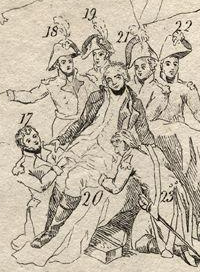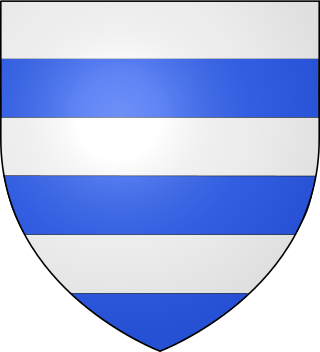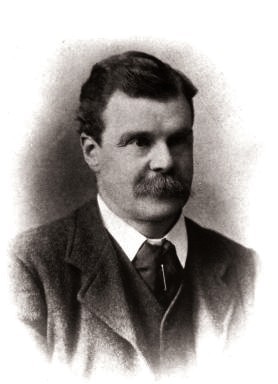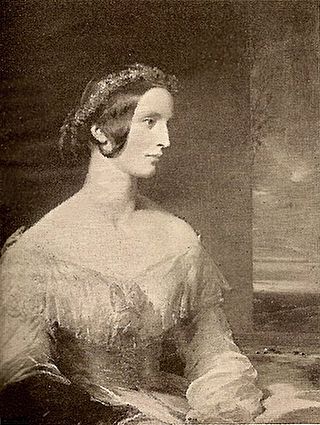
Sir John Lewis Jenkins KB KCSI (22 July, 1857 - 13 January, 1912) was a British administrator in the Imperial Civil Service.

Sir John Lewis Jenkins KB KCSI (22 July, 1857 - 13 January, 1912) was a British administrator in the Imperial Civil Service.
He was born the son of James Jenkins of Llangadog, and educated at Wadham College, Oxford. [1]
Jenkins joined the Imperial Civil Service in 1879. He served as Commissioner of Land Revenue and Reporter General of External Commerce in Bombay and later Commissioner of Commerce in Bombay between 1903 and 1906. [2] He served as a Member of the Council of the Governor of Bombay between 1909–10 and held the office of Member of the Council of the Governor-General of India between 1910 and 1912. [3] In 1911 he read the All-India address of welcome to George V at the Delhi Durbar. [4] That same year he was made a Knight Commander of the Order of the Star of India. He died suddenly in 1912 at the age of 54 following brain trouble. [5] [6]
He married Florence Mildred Trevor (1870-1956), daughter of Sir Arthur Trevor, on 18 November 1890 in Karāchi, Mahārāshtra, India. Their children were Arthur Lewis Jenkins (1892–1917), [7] Elinor May Jenkins (1893–1920), [8] Sir Evan Meredith Jenkins (1896–1985), Joyce Angharad Jenkins (1897–1983), David Llewelyn Jenkins (1899–1969), John Vaughan Jenkins (1903–1936), Sir Owain Trevor Jenkins (1907–1996). [9]

Lieutenant-General Sir John Abercromby or Abercrombie GCB was a British Army officer and Member of Parliament (MP) for Clackmannanshire from 1815 to 1817.

George Granville Harcourt was a British Whig and then Conservative Party politician.
Leslie Gilbert Pine was a British writer, lecturer and researcher in the areas of genealogy, nobility, history, heraldry and animal welfare.
Mary Anne Abercromby, 1st Baroness Abercromby was a Scottish peeress, socialite and the wife of General Ralph Abercromby.
Vice-Admiral Temple West was a British naval officer, best known for his role as second-in-command to Admiral John Byng during the Battle of Minorca in 1756.

Edward Brooke, 6th Baron Cobham, lord of the Manor of Cobham, Kent, was an English peer.
This article is about the particular significance of the year 1920 to Wales and its people.

Sir Henry de Grey of Grays Thurrock, Essex (1155–1219) was a favourite courtier of King John of England.

Tonman Mosley, 1st Baron Anslow was a British Conservative politician, businessman and judge. He was chairman of the Buckinghamshire County Council from 1904 until 1921 and chairman of the North Staffordshire Railway company from 1904 until 1923.
Sir John Osborne, 7th Baronet, was an Irish baronet, landowner and politician.
Sampson Hele of Gnaton and of Halwell, Devon, was an English politician who sat in the House of Commons in 1614 and 1624.

John Selwyn Calverley was a British sailor who competed in the 1900 Summer Olympics in Le Havre, France. Calverley took the silver in the 20+ ton.

Thomas Brooke, 8th Baron Cobham, lord of the Manor of Cobham, Kent, was an English peer.

Sir Edward Lugard was a British Army officer who served as Adjutant-General in India (1857–58) and later as Permanent Under-Secretary of State for War (1861–71) at the War Office.

Sir Arthur Charles Trevor was a British administrator and civil servant in British India.

Thomas Lister, 1st Baron Ribblesdale of Gisburne Park, Yorkshire, was a British landowner and politician who represented Clitheroe in the House of Commons between 1773 and 1790 and was raised to the peerage as Baron Ribblesdale in 1797.

Sir John Arundell IV, born at Treleigh, in the parish of St Ervan, Cornwall in about 1340 was an English knight and as son of John Arundell (III) was heir to a family that held large amounts of land in Devon and Cornwall. He died on 5 November 1376, drowned off the coast of Ireland, in a fleet going to Brittany.

Susan Broun-Ramsay, Marchioness of Dalhousie, formerly Lady Susan Georgiana Hay, was the wife of James Broun-Ramsay, 1st Marquess of Dalhousie.
Alfred Nathaniel Holden Curzon, 4th Baron Curzon, was a British aristocrat and clergyman. He was the father of George Curzon, 1st Marquess Curzon of Kedleston, who was the Conservative Viceroy of India and British Foreign Secretary.
Lieutenant Colonel William Henry Wellesley, 2nd Earl Cowley was an English aristocrat and soldier.